
Wander Through Time in Old Town Cádiz
Explore Old Town Cádiz: A blend of history, culture, and coastal charm in one of Spain's oldest cities. Discover iconic landmarks, local cuisine, and vibrant festivals.
Old Town Cádiz, known for its cobblestone streets and whitewashed buildings, offers a charming glimpse into the rich history of this ancient port city. Nestled on a narrow peninsula, this neighbourhood is a labyrinth of narrow alleyways leading to hidden squares, where locals and visitors alike gather to enjoy the vibrant atmosphere. The heart of Old Town is the magnificent Cádiz Cathedral, a baroque and neoclassical marvel with a golden dome that glows under the Andalusian sun. Nearby, the Torre Tavira offers panoramic views of the city and the sea, making it a must-visit spot for photography enthusiasts. As you explore, you'll encounter numerous tapas bars and seafood restaurants, where you can savor local delicacies like 'pescaíto frito' and 'tortillitas de camarones'. History buffs will appreciate the ancient Roman Theatre, one of the oldest in Spain, and the city's well-preserved defensive walls that tell tales of Cádiz's strategic importance over the centuries. For a more leisurely experience, stroll through the lush Alameda Apodaca or relax on the sandy shores of La Caleta Beach, a favorite spot for both locals and tourists. The Old Town also hosts numerous festivals throughout the year, including the famous Cádiz Carnival, which fills the streets with music, dancing, and colorful costumes. Whether you're here for the history, the food, or the festivals, Old Town Cádiz promises a vibrant and unforgettable experience.
Local tips in Old Town
- Wear comfortable shoes; the cobblestone streets can be uneven and require good footwear for exploring.
- Visit the Cádiz Cathedral and climb the bell tower for spectacular views of the city and coastline.
- Try to visit during the Cádiz Carnival in February for an unforgettable cultural experience.
- Sample local seafood at the Mercado Central, where you can find the freshest catches of the day.
- Plan your visit to the Torre Tavira on a clear day for the best panoramic views.
Wander Through Time in Old Town Cádiz
Old Town Cádiz, known for its cobblestone streets and whitewashed buildings, offers a charming glimpse into the rich history of this ancient port city. Nestled on a narrow peninsula, this neighbourhood is a labyrinth of narrow alleyways leading to hidden squares, where locals and visitors alike gather to enjoy the vibrant atmosphere. The heart of Old Town is the magnificent Cádiz Cathedral, a baroque and neoclassical marvel with a golden dome that glows under the Andalusian sun. Nearby, the Torre Tavira offers panoramic views of the city and the sea, making it a must-visit spot for photography enthusiasts. As you explore, you'll encounter numerous tapas bars and seafood restaurants, where you can savor local delicacies like 'pescaíto frito' and 'tortillitas de camarones'. History buffs will appreciate the ancient Roman Theatre, one of the oldest in Spain, and the city's well-preserved defensive walls that tell tales of Cádiz's strategic importance over the centuries. For a more leisurely experience, stroll through the lush Alameda Apodaca or relax on the sandy shores of La Caleta Beach, a favorite spot for both locals and tourists. The Old Town also hosts numerous festivals throughout the year, including the famous Cádiz Carnival, which fills the streets with music, dancing, and colorful costumes. Whether you're here for the history, the food, or the festivals, Old Town Cádiz promises a vibrant and unforgettable experience.
Iconic landmarks you can’t miss
The flower market square
Experience the vibrant charm of Cadiz at the Flower Market Square, where colorful blooms and local culture come alive.

Torre Tavira
Explore Torre Tavira, a historical landmark in Cádiz with stunning views and rich cultural insights, perfect for history enthusiasts and travelers alike.

Castillo de Santa Catalina
Discover the historic Castillo de Santa Catalina in Cádiz, a stunning fortress offering breathtaking views and a glimpse into Spain's rich maritime history.

The 1812 Constitution Monument
Explore the 1812 Constitution Monument in Cádiz, a historic landmark surrounded by serene gardens symbolizing liberty and democracy.

Centro histórico de Cadiz
Explore the captivating historic center of Cádiz, where ancient architecture meets vibrant culture and stunning coastal views.

Baluarte de la Candelaria
Discover the historic Baluarte de la Candelaria in Cádiz, a stunning fortress with breathtaking ocean views and rich maritime heritage.

Murallas De San Carlos
Discover the stunning Murallas De San Carlos, a historic fortress in Cádiz offering breathtaking views and a glimpse into Spain's maritime history.

Plaza de San Antonio
Explore the enchanting Plaza de San Antonio, a historical gem in Cádiz filled with vibrant culture, stunning architecture, and local flavors.

Casa Palacio del Almirante
Explore the historical elegance of Casa Palacio del Almirante in Cádiz, where rich architecture meets captivating cultural heritage.

Carrusel Antiguo
Discover the charm of Carrusel Antiguo in Cádiz, where history, culture, and joy come together in a timeless carousel experience.

Unmissable attractions to see
Playa de La Caleta
Experience the beauty and vibrant atmosphere of Playa de La Caleta, the perfect beach destination in Cádiz, Spain for relaxation and recreation.

Parque Genovés
Explore the lush beauty and tranquility of Parque Genovés, a botanical gem in Cádiz offering serene pathways, vibrant flora, and family-friendly spaces.

Castillo de Santa Catalina
Experience the rich history and stunning views of Castillo de Santa Catalina, a historical treasure in the heart of Cádiz, Spain.

The 1812 Constitution Monument
Discover Cádiz's 1812 Constitution Monument, a stunning symbol of democracy and freedom, nestled in a serene park setting for all to enjoy.

Teatro Romano de Cádiz
Explore the ancient wonders of Teatro Romano de Cádiz, where history and culture come alive in the heart of this enchanting Spanish city.

Centro histórico de Cadiz
Explore the historic center of Cádiz, a captivating blend of rich history, stunning architecture, and vibrant local culture in the heart of Andalusia.

Baluarte de la Candelaria
Explore the historical Baluarte de la Candelaria in Cádiz, a fortress offering stunning views and rich cultural experiences in the heart of Spain's coastal gem.

Mina Square
Discover the serene beauty of Mina Square in Cadiz, a lush park that blends nature, culture, and community in the heart of the city.

Yacimiento Arqueológico Gadir
Explore the ancient Phoenician city of Gadir at Yacimiento Arqueológico, a captivating archaeological site in the heart of Cádiz, Spain.

Plaza de la Candelaria
Discover the charm of Plaza de la Candelaria, a serene park in Cádiz blending nature and culture for an unforgettable experience.

Museo del Títere
Experience the vibrant world of puppetry at Museo del Títere in Cádiz, where art, history, and entertainment unite for all ages.

Museo de las Cortes de Cádiz
Uncover the historical significance of Cádiz at the Museo de las Cortes, a must-visit local history museum showcasing Spain's political evolution.

Plaza de España
Discover the serene beauty of Plaza de España in Cádiz, a perfect blend of lush gardens and rich history, inviting you to relax and explore.

Catacumbas del Beaterio
Explore the mysterious Catacumbas del Beaterio in Cádiz, where history and intrigue come together in an unforgettable underground journey.
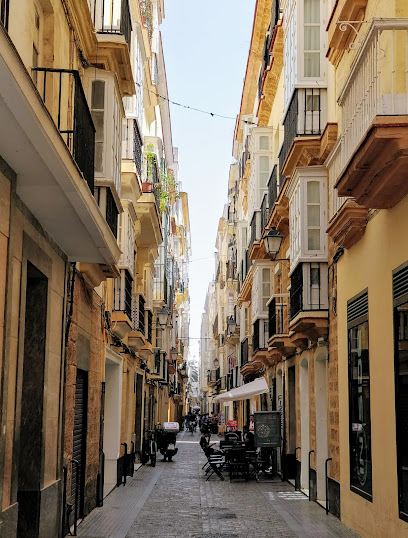
Paseo Marítimo de Cádiz
Discover the beauty of Paseo Marítimo de Cádiz, a stunning waterfront promenade blending sun, sea, and vibrant city life.
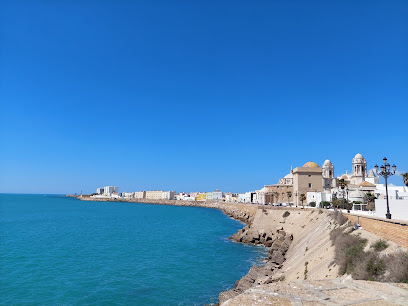
Essential places to dine
Taberna Casa Manteca
Discover authentic Spanish cuisine at Taberna Casa Manteca in Cádiz—where every bite tells a story of tradition and flavor.

El Faro de Cádiz
Discover El Faro de Cádiz: A premier seafood restaurant offering authentic Spanish dishes with breathtaking ocean views.

The Tapería of Columela
Experience authentic Spanish tapas at The Tapería of Columela in Cádiz—where flavor meets tradition in a vibrant setting.

Taberna El tío de La Tiza
Experience authentic Andalusian cuisine at Taberna El Tío de La Tiza – a must-visit tavern in the heart of Cádiz.

Restaurante La Isleta de la Viña
Experience the vibrant flavors of Mediterranean cuisine at Restaurante La Isleta de la Viña in Cádiz - where tapas meet live music.

La Candela
Experience authentic Mediterranean flavors at La Candela, a top-rated tapas bar in Cádiz offering a unique culinary adventure.

Restaurante El Aljibe
Savor exquisite Mediterranean and tapas cuisine at Restaurante El Aljibe in Cádiz – where local flavors come alive.

Restaurante Café Royalty - Restaurantes en Cádiz
Discover exquisite Mediterranean flavors at Restaurante Café Royalty in Cádiz – where tradition meets culinary artistry.
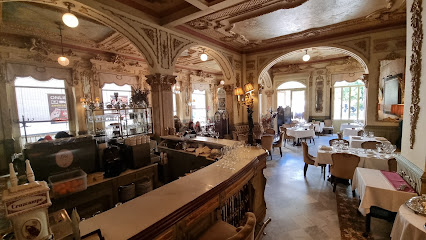
Casa Lazo
Discover authentic Spanish cuisine at Casa Lazo in Cádiz—where tradition meets flavor in an inviting atmosphere.

Puerta del Eden Restaurant
Experience authentic Andalusian cuisine at Puerta del Eden Restaurant in Cádiz - a culinary gem blending tradition and modern flair.

Markets, malls and hidden boutiques
El Corte Inglés Bahía de Cádiz
Explore El Corte Inglés Bahía de Cádiz, a premier shopping mall with a diverse selection of brands, dining options, and a vibrant atmosphere in the heart of Cádiz.

Centro histórico de Cadiz
Explore the historic center of Cádiz, a captivating blend of ancient architecture, cultural vibrancy, and culinary delights in the heart of Andalusia.
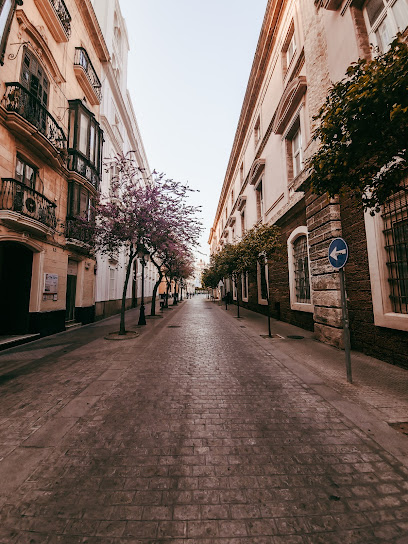
LA VACA ATADA
Discover La Vaca Atada in Cádiz, a charming café and bar known for its delectable cakes and inviting atmosphere, perfect for any traveler.

Carrefour Market
Discover local flavors and essentials at Carrefour Market in the heart of Cádiz, your go-to supermarket for a delightful shopping experience.
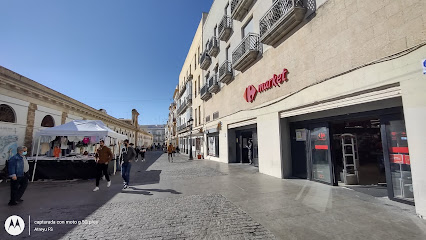
Clandestine Library
Explore the Clandestine Library in Cádiz: a cozy café and bookstore offering the best of literature and coffee in a charming atmosphere.

Museum-store of Cadi-Cadi
Explore Cádiz's artistic soul at the Museum-Store of Cadi-Cadi, where unique souvenirs and local craftsmanship await.

La Miga De Oro
Experience the charm of Cádiz at La Miga De Oro, a cozy coffee shop serving exceptional brews and delectable pastries.

Joyería Dolmen - Antonio Collantes
Discover the artistry of handcrafted jewelry at Joyería Dolmen - Antonio Collantes in Cádiz, where tradition meets elegance.

Sherry Wines Shop
Explore the rich diversity of sherry wines at Sherry Wines Shop in Cádiz, where expert guidance and local flavors await every visitor.

Mechanic (Authentic Shop)
Explore Cádiz's premier clothing boutique offering stylish and high-quality garments that capture the essence of authentic fashion.

Essential bars & hidden hideouts
Bar La Tabernita
Discover the authentic flavors of Cádiz at Bar La Tabernita, a top-rated tapas bar offering a vibrant atmosphere and delectable dishes.

Bar El Laurel
Discover the vibrant flavors and lively atmosphere of Bar El Laurel, a must-visit bar and restaurant in the heart of Cádiz.
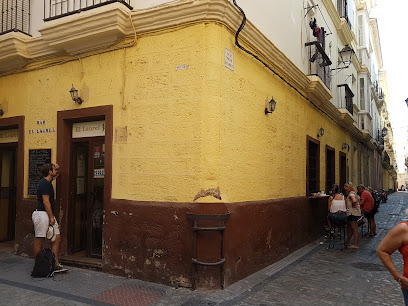
Woodstock Bar - Cádiz
Discover the lively ambiance of Woodstock Bar in Cádiz, where live music and great drinks unite for an unforgettable nightlife experience.

O'Connell's
Experience a vibrant Irish pub atmosphere in Cádiz, with hearty dishes, a wide selection of drinks, and live entertainment!
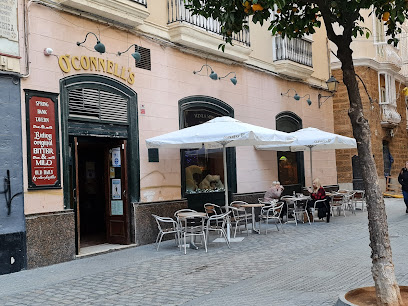
EVOHÉ
Discover the vibrant nightlife of Cádiz at EVOHÉ, a lively pub and cocktail bar featuring live music and exquisite drinks.

Rollin'Rock Pub
Discover the vibrant nightlife of Cádiz at Rollin'Rock Pub, where locals gather for drinks, music, and unforgettable experiences.

Habana Café
Experience authentic Spanish tapas and local wines at Habana Café, a vibrant bar in the heart of Cádiz, capturing the essence of Andalusian culture.

Medussa Music Bar
Discover the vibrant nightlife of Cádiz at Medussa Music Bar, where live piano music and delightful cocktails create an unforgettable experience.

Pub La Batería
Discover the vibrant ambiance and delicious tapas at Pub La Batería, a must-visit pub in the heart of Cádiz for an authentic local experience.
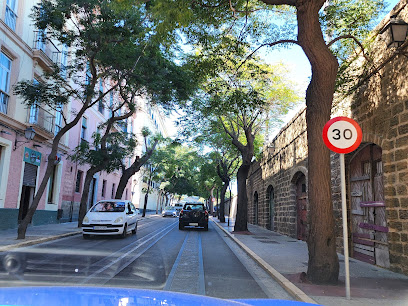
Aleph Cocktail Club
Discover the vibrant nightlife of Cádiz at Aleph Cocktail Club, where exquisite cocktails meet an inviting atmosphere for an unforgettable experience.

Local Phrases
-
- HelloHola
[oh-lah] - GoodbyeAdiós
[ah-dee-ohs] - YesSí
[see] - NoNo
[noh] - Please/You're welcomePor favor/De nada
[por fah-vor/de nah-dah] - Thank youGracias
[grah-thyahs] - Excuse me/SorryPerdón/Lo siento
[pair-dohn/loh see-en-toh] - How are you?¿Cómo estás?
[koh-moh ehs-tahs] - Fine. And you?Bien. ¿Y tú?
[byen. ee too] - Do you speak English?¿Hablas inglés?
[ah-blahs een-glays] - I don't understandNo entiendo
[noh ehn-tyen-doh]
- HelloHola
-
- I'd like to see the menu, pleaseMe gustaría ver el menú, por favor
[may goo-stah-ree-ah behr ehl meh-noo, por fah-vor] - I don't eat meatNo como carne
[noh koh-moh kahr-neh] - Cheers!¡Salud!
[sah-lood] - I would like to pay, pleaseMe gustaría pagar, por favor
[may goo-stah-ree-ah pah-gahr, por fah-vor]
- I'd like to see the menu, pleaseMe gustaría ver el menú, por favor
-
- Help!¡Ayuda!
[ah-yoo-dah] - Go away!¡Vete!
[veh-teh] - Call the Police!¡Llama a la Policía!
[yah-mah ah lah poh-lee-see-ah] - Call a doctor!¡Llama a un médico!
[yah-mah ah oon meh-dee-koh] - I'm lostEstoy perdido
[ehs-toy pair-dee-doh] - I'm illEstoy enfermo
[ehs-toy ehn-fehr-moh]
- Help!¡Ayuda!
-
- I'd like to buy...Me gustaría comprar...
[may goo-stah-ree-ah kohm-prahr...] - I'm just lookingSolo estoy mirando
[soh-loh ehs-toy meer-ahn-doh] - How much is it?¿Cuánto cuesta?
[kwan-to kwehs-tah] - That's too expensiveEsto es demasiado caro
[ehs-toh ehs deh-mah-syah-doh kah-roh] - Can you lower the price?¿Puede rebajar el precio?
[pweh-deh reh-bah-har ehl pree-syoh]
- I'd like to buy...Me gustaría comprar...
-
- What time is it?¿Qué hora es?
[keh oh-rah ehs] - It's one o'clockEs la una en punto
[ehs lah oo-nah ehn poon-toh] - Half past (10)Y media (10)
[ee meh-dee-ah (dheez-eez)] - MorningMañana
[mah-nyah-nah] - AfternoonTarde
[tahr-deh] - EveningNoche
[noh-cheh] - YesterdayAyer
[ah-yehr] - TodayHoy
[oy] - TomorrowMañana
[mah-nyah-nah] - 1Uno
[oo-noh] - 2Dos
[dohs] - 3Tres
[trehs] - 4Cuatro
[kwah-troh] - 5Cinco
[theen-koh] - 6Seis
[says] - 7Siete
[syeh-teh] - 8Ocho
[oh-choh] - 9Nueve
[nweh-veh] - 10Diez
[dyehth]
- What time is it?¿Qué hora es?
-
- Where's a/the...?¿Dónde está...?
[dohn-deh ehs-tah] - What's the address?¿Cuál es la dirección?
[kwal ehs lah dee-rehk-syon] - Can you show me (on the map)?¿Puedes mostrarme (en el mapa)?
[pweh-dehs mohs-trar-meh (ehn ehl mah-pah)] - When's the next (bus)?¿Cuándo es el próximo (autobús)?
[kwan-doh ehs ehl proh-ksee-moh (ow-toh-boos)] - A ticket (to ....)Un billete (a ....)
[oon bee-yeh-teh (ah ....)]
- Where's a/the...?¿Dónde está...?
History of Old Town
-
Cádiz, known as Gadir in ancient times, was founded by the Phoenicians around 1100 BC. Its strategic position at the entrance of the Mediterranean made it a significant trading post. The Phoenicians established a thriving commerce based on trade with other civilizations, leading to Cádiz becoming one of the oldest continuously inhabited cities in Europe.
-
Under Roman rule in the 2nd century BC, Cádiz flourished as a major urban center. The construction of monumental structures, including temples, an amphitheater, and a forum, marked this period. The remnants of these Roman constructions can still be seen in the Old Town, showcasing the city's historical significance during the Roman Empire.
-
Cádiz fell to the Moors in the early 8th century, leading to a rich cultural synthesis. The Islamic influence is evident in the architecture and urban planning of the Old Town. The Kasbah, a fortified area, was developed during this period, reflecting the defensive needs and aesthetic preferences of the time. This era contributed to the city’s diverse cultural landscape.
-
During the 16th century, Cádiz became a crucial port for the Spanish Empire, especially during the Age of Discovery. It served as the primary point for the trade of goods from the Americas, leading to economic prosperity. This wealth is reflected in the baroque architecture of the Old Town, particularly in the grand churches and palaces built during this boom.
-
The Old Town of Cádiz played a pivotal role during the Peninsular War, particularly in 1812 when the Cortes de Cádiz convened and drafted the Cadiz Constitution. This document was one of the first liberal constitutions in Europe, promoting ideas of democracy and human rights. The historical significance of this event is commemorated in various monuments across the city.
-
The 20th century brought challenges, including the Spanish Civil War and World War II, affecting Cádiz's economy and population. However, the city began to recover in the latter half of the century. The Old Town's historical sites were preserved and restored, reflecting the resilience of its cultural heritage and the city's dedication to maintaining its rich history.
Old Town Essentials
-
Old Town Cádiz is easily accessible from other neighborhoods within the city. If you're coming from La Viña or the New Town, walking is the best option, as the distance is manageable and the streets are charming. Alternatively, local buses (such as lines 1 and 2) connect these areas to Old Town. For those arriving from outside Cádiz, the main train station (Estación de Renfe) is located near the Old Town, with connections from major cities like Seville and Málaga.
-
Old Town is a pedestrian-friendly area, making walking the most enjoyable way to explore its narrow streets, historical sites, and plazas. Bicycles can be rented from local shops, and there are bike lanes in some parts. Taxis are available and can be hailed on the street or booked via phone. While there is no tram or metro system in Cádiz, the bus service is reliable for reaching areas outside the Old Town.
-
Old Town Cádiz is generally safe for tourists. However, like any urban area, it’s wise to take precautions. Be cautious in less crowded areas at night and keep your belongings secure, especially in busy spots like markets or during festivals. While violent crime is rare, petty theft, such as pickpocketing, can occur in crowded places. It’s advisable to avoid poorly lit streets after dark and to stay alert in popular tourist areas.
-
In case of an emergency, dial 112 for police, fire, or medical assistance. The local hospital, Hospital Puerta del Mar, offers emergency services. Pharmacies are readily available and can assist with minor health issues. It’s recommended to have travel insurance that covers medical emergencies and to carry a copy of your passport in case you need to present identification.
-
Fashion: Do wear comfortable shoes for walking and light clothing during the summer. Don’t wear beach attire away from the beach. Religion: Do respect the local customs, especially in churches; cover shoulders and knees. Public Transport: Do give up your seat for elderly or pregnant passengers. Don’t play loud music or eat on public transport. Greetings: Do greet people warmly with a smile; a handshake is common. Eating & Drinking: Do try local tapas and enjoy meals at traditional bars. Don’t drink excessively in public or eat in sacred spaces.
-
To experience Old Town like a local, visit the Mercado Central de Abastos for fresh produce and local delicacies. Try to attend a flamenco show to immerse yourself in the local culture. The best time to explore is during the early morning or late afternoon when the streets are less crowded. Engage with locals at tapas bars, as they often share stories and recommendations about the city's history. Don’t forget to try the famous 'pescaíto frito' (fried fish) while you're here.
Nearby Cities to Old Town
-
Things To Do in Casemates Square
-
Things To Do in Gibraltar
-
Things To Do in Main Street
-
Things To Do in Moorish Castle
-
Things To Do in Queensway Quay Marina
-
Things To Do in Tangier
-
Things To Do in Alameda Botanic Gardens
-
Things To Do in Catalan Bay
-
Things To Do in St. Michael's Cave
-
Things To Do in Gorham's Cave Complex
-
Things To Do in Europa Point
-
Things To Do in Seville
-
Things To Do in Huelva
-
Things To Do in Ronda
-
Things To Do in Asilah













